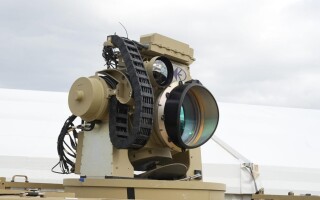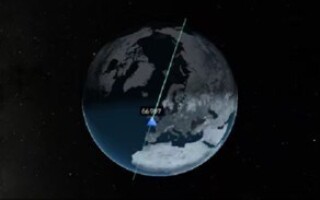Next-gen military radar system design innovations
StoryJanuary 21, 2016
Gallium nitride (GaN) transmitters, radio frequency (RF) tiles, and solid-state modular 3-D radar are among the latest innovations in next-generation military radar systems to embrace commercial-off-the-shelf (COTS) components to reduce costs. Designers of these systems have also adopted modular design to streamline installation and maintenance.
Designers of next-gen military radar systems are under constant pressure to deliver enhanced capability to track and counter increasingly sophisticated threats, all at the lowest cost possible, while also factoring in ease of installation and upgrades.
Three such recent industry designs include the Digital Array Row Transmitter (DART) from Lockheed Martin, SPAR Tiles from MACOM, and the Artisan 3-D radar system from BAE Systems.
Lockheed Martin’s next-gen radar technology
Lockheed Martin designed its Digital Arrow Row Transceiver (DART) to be form- and fit-compatible with the current transmit-and-receive line replaceable units (LRUs) in its legacy radar system antennas.
“Leveraging the prime power, efficiency, and cost benefits GaN (gallium nitride) transmitter technology offers, DART combines the basic functionality of the antenna transmitter LRU and receiver LRU into one,” says Mark Mekker, director of surveillance radar for Lockheed Martin. “A modular design provides enhanced maintenance capabilities to lower life cycle costs.”
In terms of detection capabilities, although DART was initiated with obsolescence and affordability goals in mind, the technology can also be used to increase RF performance. “With GaN technology, the power handling capability and higher junction temperature tolerances of DART provides an opportunity to increase the duty cycle on the radar system,” Mekker says. “And with finer controls of critical transmit output parameters, we can enhance the system’s radar beam-shaping capabilities. Lockheed Martin works specifically with customers to configure their radar systems to their mission objectives, and DART certainly increases the options to support this.”
As for anti-jamming and anti-spoofing, DART “provides finer control of critical transmit output parameters that could certainly apply to special anti-jamming or anti-spoofing capabilities,” Mekker notes.
Perhaps the most surprising aspect of DART is that the maturity of GaN technology isn’t being driven by the military industry, as Mekker points out, but instead was primarily driven by the telecom industry well over a decade ago.
“Lockheed Martin recognized the strength of this technology and how it could be used in radar systems and so we partnered with several leaders to develop GaN technology. While others in the military radar industry have opted to develop and build GaN technology in-house, we adopted a foundry-neutral approach for our new transmit/receive capability,” Mekker explains.
This enables Lockheed Martin to “leverage the most mature GaN processes in the industry – being used by many instead of one – and provides multiple sources of supply for GaN devices to help drive competition and lower costs,” Mekker says. “As a result, Lockheed Martin had GaN working in operational radar systems more than six years ago, which allows us to pass cost savings to our customers.”
MACOM SPAR Tiles
MACOM engineers created SPAR Tiles, which are RF assemblies containing antenna elements, gallium arsenide (GaAs) and gallium nitride (GaN) semiconductors, transmit and receive modules, and RF and power distribution networks.
“When combined with other signal-generation and receive-and-control electronics, the composite assembly forms the foundation for the multifunction phased-array radar (MPAR) planar active electronically scanned antenna (AESA) for the radar system,” says Doug Carlson, vice president of strategy for MACOM. (See Figure 1.)
Figure 1: Pictured is a SPAR Tile developed by MACOM. Photo courtesy of MACOM.
(Click graphic to zoom)
In fact, SPAR Tiles are a fundamental change in the way the industry can go about building phased arrays or any active antenna. “For most of the history of these systems, they were built using a slat-style design or brick architecture in which the electronics were perpendicular to the antenna face,” Carlson explains. “With SPAR Tiles, also known as scalable planar array tiles, everything is built using a completely planar technology. This allows us to exploit commercial manufacturing technologies and lower the overall manufacturing costs of civil and defense systems.”
The size of SPAR Tiles is determined by the wavelength of the system it is operating in. “Our S-band tile, for example, is about 16 inches square. In future high-frequency applications of this technology, as they move into 5G applications, they’ll become quite small,” Carlson adds.
The main benefit of SPAR Tiles? While they preserve the most advanced characteristics of radar systems, the cost point is as much as five times lower than current technology. “The major thrust here is affordability, but to also support multifunctionality, multimission capability – aimed at land, sea, and eventually air domain applications,” he says.
For military applications, “if you think of a radar as a sensor, we use sensors in installations on the battlefield, where it’s a huge asset,” Carlson continues. “If the sensor can be made more affordable, sensors can be used as a distributed network of sensors on trucks and UAVs [unmanned aerial vehicles] – all over the battlefield, operating at different frequencies to watch out for different threats. It’ll change the way we view the battlefield and usher in a new level of information and communications on the move. The directivity and agility that active antennas bring to the battlefield are enabling effective communications while in motion – without detection by the adversary.”
MACOM manufactures SPAR Tiles by exploiting the same manufacturing technologies used to build the motherboard in computers or electronics. “It’s a very different approach than having dedicated factories building one radar system over a long period of time. By exploiting the larger electronics industry, we can get the absolute lowest possible manufacturing cost,” Carlson explains.
Another way to reduce costs is to use a combination of custom and COTS to build these products. “In general, in power and digital control it’s all COTS components … power regulators, FPGAs, etc.,” he says. “Closer to the antenna, the solution becomes more custom.”
One of the most surprising aspects about SPAR Tiles is the cost reduction that comes from simply changing manufacturing approaches. “Most systems implemented today are in a brick architecture approach,” Carlson says. “But within the military domain, virtually every antenna application is moving to an active antenna – whether it’s communications or radar – so making these systems affordable is paramount to getting them implemented. This cost reduction offers a path forward.”
What sorts of radar trends is MACOM seeing? One of the biggest involves the shift to going digital. “Do you go digital to an element or to a subarray?” points out Carlson. “It’s currently a cost versus performance tradeoff, but there’s a very active push toward going digital to the element. We’re very active with this technology thrust. Another one is to increase broadband capability that will enable a broad array of missions to be accomplished by a single array. Very broad frequency ranges make it possible to do communications radar, electronic warfare, jamming, etc., simultaneously out of the same array.”
As far as a timeline for SPAR Tiles, shipping in low production rates has already begun. “By 2020, this will be the de facto standard of how systems are built by the DoD (Department of Defense),” Carlson says. “We’re looking at a similar timeline for next-generation civil telecommunications and air traffic control within the U.S.”
What’s next for the technology? In the defense domain, Carlson believes the technology is going to go from ground to sea applications, and then eventually to air. “It’ll evolve to higher frequencies and much broader bands,” he adds.
On the civil side, Carlson says he expects it to go in the direction of telecommunications. “If you look at next-generation network architectures, they’re expected to become highly dependent on active antenna technology or phased-array technology to optimize signal link and data rate,” he says. “In the telecom domain, cost is of primary importance. For those implementations, this technology will support applications spanning 2.5 GHz and 3.5 GHz base stations all the way up through upper millimeter-wave E-band and beyond.”
BAE Systems’ Artisan 3-D radar system
BAE Systems has developed the “Artisan 3-D radar system” for the U.K. Procurement Agency. The system was designed to meet the challenges of operating within the naval domain –including detecting fast and agile air and surface threats that materialize with little warning.
To this end, Artisan can operate within signal-populated environments and cut through an interference equivalent to 10,000 mobile phone signals. It can also track more than 800 targets at any given time, and identify a target the size of a tennis ball hurtling toward it at a speed of Mach 3 (>2,000 mph) from more than 25 kilometers (approximately 15.5 miles) away. All of this capability comes with an antenna that weighs less than 700 kilograms (just over 1,500 pounds), which is roughly equivalent to the weight of an adult male polar bear. (Figure 2.)
Figure 2: This image shows the Artisan 3-D system in the process of being installed on a Queen Elizabeth Class carrier. Photo courtesy of BAE Systems.
(Click graphic to zoom by 1.9x)
“Our system’s performance can be achieved amid the most difficult of environments – mixed land and sea clutter, challenging climatic and atmospheric conditions, and real-world objects – such as hostile electronic countermeasures,” says Dominic Morley, BAE Systems’ international business development manager for naval radar. Artisan delivers “a simultaneous air and surface picture that provides situation awareness and target detection to support the weapons system and provide improved ship defense.”
Artisan contains a range of advanced signal and data processing techniques, which according to Morley, provides “high-quality tracks at low latency.”
The system was developed primarily to satisfy multiplatform, multirole military applications for medium-range data to enable an air picture compilation; furnish multimode operation to suit all prevailing operational scenarios; contribute advanced target indication capability (integrated with the Sea Wolf and Sea Ceptor weapons systems) to support any of the currently active surface-to-air missiles; track classification and characterization to support combat ID; and provide accurate data for successful weapon system operation, including resolution of targets.
“Artisan provides surface surveillance, air-traffic management, jammer suppression, surveillance and tracking, and graceful degradation to meet maximum operational availability,” Morley says.
The radar offers “optimized performance in littoral regions with severe clutter by using adaptive techniques and a dedicated littoral warfare defense mode,” he adds. It also provides “electronic countermeasures (ECM) via adaptive beamforming techniques in severe ECM environments.”
Artisan is low-maintenance, thanks to its modular solid-state construction. Moreover, the install time is typically within four to eight weeks. This makes the radar “ideally suited to ship refits,” Morley says.
This modern system also happens to be software-defined and highly adaptive. “One of our key considerations during the trials leading up to the first operational deployment was to fully replicate the exceptional sensitivity achieved in the land-based test environment and to tune it for the seagoing environment,” he says.
As of late 2015, this process was largely complete and the system is currently fitted to 10 Royal Navy warships, including eight Type 23 frigates and the future aircraft carrier HMS Queen Elizabeth.
“Artisan is already proving to be a highly capable radar –providing significantly greater track detection ranges than its predecessor against more complex and demanding threats,” Morley notes. “Trial analysis and assessment are ongoing to ensure that all aspects of performance are met.”







